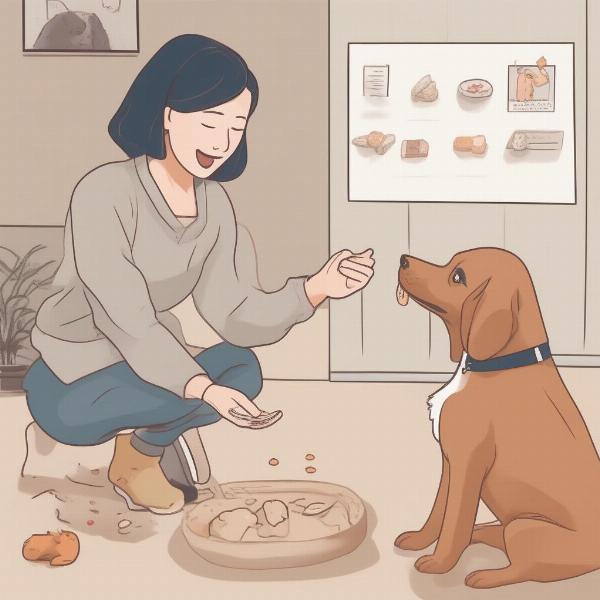Understanding and utilizing Japanese dog commands can be a rewarding experience, strengthening the bond with your canine companion while offering a unique training approach. This guide delves into the nuances of Japanese commands, providing practical advice and insights for dog owners of all levels, from beginners to seasoned trainers.
Why Use Japanese Dog Commands?
Many trainers find that using a different language for commands can help prevent confusion for the dog, especially if they’ve already learned some English commands incorrectly. Japanese words also tend to be short and sharp, making them easy for dogs to distinguish and remember. Plus, it can be a fun and culturally enriching experience for both you and your pet.
Essential Japanese Dog Commands for Everyday Use
Here are some fundamental Japanese commands that will form the bedrock of your training:
- Osuwari (おすわり): Sit. This is probably the most commonly used command, and a great place to start your Japanese training journey.
- Fuse (伏せ): Down. This command instructs your dog to lie down.
- Koi (来い): Come. A crucial command for recall, ensuring your dog returns to you when called.
- Matsu (待て): Wait or Stay. Teaches your dog patience and impulse control.
- Yoshi (よし): Okay or Good. A positive reinforcement marker, signaling to your dog that they’ve performed the command correctly.
Building a Strong Foundation: Tips for Teaching Japanese Commands
Consistency and positive reinforcement are key. Start by pairing the Japanese command with the corresponding English command your dog may already know. For example, say “Osuwari (Sit)” while simultaneously gesturing for your dog to sit. Reward them with praise and a treat when they perform the action correctly. Gradually phase out the English command as your dog begins to associate the Japanese word with the desired behavior.
 Training a Dog with Japanese Commands
Training a Dog with Japanese Commands
Beyond the Basics: Expanding Your Japanese Command Vocabulary
Once your dog has mastered the basic commands, you can expand their repertoire with more advanced instructions:
- Akemasu (開けます): Open. Useful for teaching your dog tricks or retrieving items.
- Tojimasu (閉じます): Close. A counterpart to “Akemasu”, further enhancing trick training.
- Hanashimasu (離します): Release or Drop it. Essential for retrieving games and preventing resource guarding.
Addressing Common Challenges in Japanese Dog Training
Some dogs might initially struggle to differentiate between Japanese and English commands, especially if the sounds are similar. Clear enunciation and consistent pairing with actions are crucial for overcoming this hurdle. Patience and positive reinforcement will ultimately lead to success.
Conclusion
Training your dog with Japanese commands can be a fulfilling and unique bonding experience. By following these guidelines, you’ll not only enhance your communication with your canine companion but also add a fun and culturally enriching dimension to your training routine. Remember that patience, consistency, and positive reinforcement are the keys to successful training.
FAQ
-
Is it harder to train a dog with Japanese commands? Not necessarily. The key is consistency and clear communication, regardless of the language used.
-
Can I mix Japanese and English commands? While possible, it’s generally recommended to stick to one language for training to avoid confusion.
-
What if my dog already knows English commands? You can gradually introduce Japanese commands alongside the English ones, phasing out the English as your dog learns the new commands.
-
Are there any resources for learning Japanese dog commands? Yes, many online resources and books offer comprehensive lists and pronunciation guides.
-
How long does it take to teach a dog Japanese commands? Like any training, it varies depending on the dog, their breed, and your consistency. Be patient and celebrate small victories.
-
Can older dogs learn Japanese commands? Absolutely! Older dogs can learn new tricks and commands with the right approach and patience.
-
Are there any cultural considerations when using Japanese dog commands? It’s always respectful to learn the correct pronunciation and meaning of the commands to avoid misusing the language.
Related Articles on ILM Dog
About ILM Dog
ILM Dog (ilmdog.com) is your premier online resource for expert advice on dog breeds, health, training, nutrition, grooming, and much more. Whether you’re a first-time dog owner or a seasoned expert, we provide practical tips and guidance on every aspect of dog care. From choosing the right breed to understanding your dog’s behavior, ILM Dog is your trusted companion on your dog ownership journey. We specialize in connecting dog lovers with reputable breeders and providing comprehensive information on dog health, training, and nutrition. For any inquiries, contact us via email at [email protected] or call us at +44 20-3965-8624. ILM Dog is here to help you provide the best possible care for your furry friend.